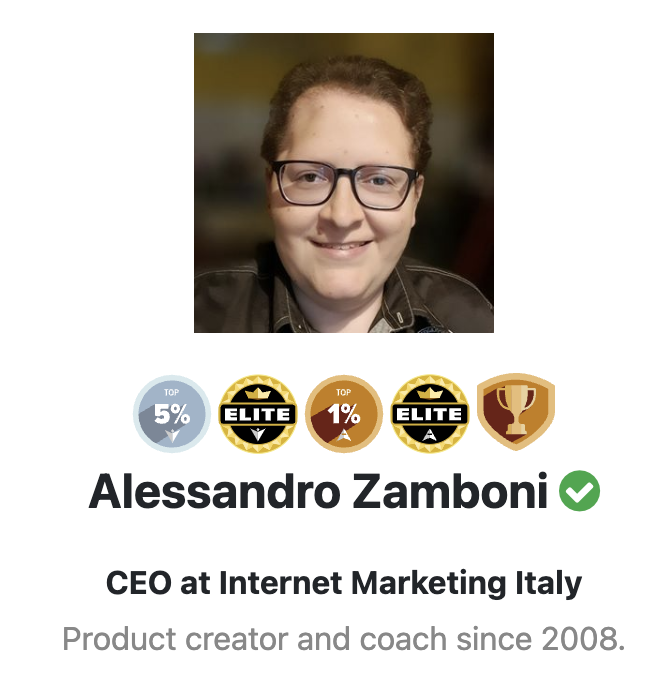It’s a well-known fact among marketers that it’s easier to sell to a repeat customer than it is to acquire a new one. That said, there’s one type of customer that’s even more effortless to sell to…
And that’s someone who’s already in a ‘buying mood’.
Let’s assume you are going to sell a new ChatGPT guide for $17. After the initial purchase, the customer is presented with another offer: a bundle of ChatGPT prompts for online marketers you sell for $27.
This new prompt bundle is known as an upsell. Since the customer has already bought the first product, they are more receptive to your sales ‘pitch’ and more likely to buy again.
It goes without saying that a fraction of your customers who bought the first product will usually get the upsell too. The take-up rate can be anywhere from 20% to 60%, based on my personal results.
How well your upsell converts will depend on many variables, ranging from the price to the sales copy to the relevance of the product compared to the first one.
Your Key Takeaway
Upsells work and will increase your average customer value. Instead of just making $17 per customer, you will now be making $60, $100 or more (if they purchase the upsell too).
This increase in profit will allow you to spend more on your marketing, if you’re doing paid advertising and so on.
Now that we’ve established the importance of having upsells in your sales funnel, let’s look at a crucial mistake so many marketers make.
Avoid This Mistake At All Cost!
When you are selling a product, it should stand alone on its own merit.
For example, if you are selling a guide showing bloggers how to get more traffic with a unique technique, your upsell should NOT be a plugin you have created that’s crucial to making the technique work.
Now the customer will feel cheated because they need to buy a second product to make the first one work.
In this example, you’d do well to include the plugin with your guide, and the upsell could be an add-on that speeds up the entire process. In this way, the customer will be able to make your technique work, but if they want faster results, they can get the upgrade (upsell).
That’s how you do upsells the right way.

The Difference Between Upsells And One-Time Offers (OTOs)
Like the name suggests, a one-time offer is only shown to the customer once. This creates scarcity and prompts the buyer to get it while they can because they will not have an option to get it again.
Once again, marketers make a cardinal error here by calling their upsell a one-time offer, only for the same offer to be shown again on the access page, in emails, on the website and so on.
This defeats the purpose and makes customers assume that even if they don’t get the one-time offer now, the desperate marketer will show it to them repeatedly in future to drum up more sales.
So if you’re planning to show the offer again in future, just let it be an upsell/upgrade and avoid calling it a ‘one-time offer’.
What Can You Offer As An Upsell?
The rule of thumb when creating an upsell is to give the customer more of what they just purchased.
If they bought a package of AI graphics for children’s stories for $17, your upsell can be a set of children’s stories they can republish or change that costs only $30 instead of $100.
This upsell is a 70% discount, and you can bet that quite a few people will get the upsell to save money. After all, they are going to need it.
This principle applies to most other products, such as digital planners, email templates, eBooks, plugins, WordPress themes, and so on.
Another way to offer an upsell is to offer an opportunity to either speed up the process to get results faster and/or an upgrade to simplify the process.
For example, if you have a training course showing authors how to publish in the Kindle marketplace and drive free organic traffic to their books, the upsell could be a training showing these authors how to use paid traffic to get faster, easier results, and more sales.
People want things fast, and they want them easy. By offering upgrades that address these wants, you will improve your upsells’ conversions.
A Few Problems To Fix Before You Go Live
Pricing
Figuring out your pricing can be a bit of a headache. Once again, it’s all about testing to see what works for you. Generally, if you are selling digital products, the upsell will cost 1,5 to 3 times more than the front-end offer.
If the customer chooses not to get the upsell, you should send them to a downsell that’s about 30–50% cheaper than the upsell. But I don’t do that because I think it is wrong compared to someone who bought at full price.
Generally, people pass on the upsell because of budget concerns. If you present them with another offer at a lower price, it will seem more palatable and they will probably buy the downsell. I leave you this choice to you.
Do note: NEVER offer the upsell at a discounted rate as your downsell.
For example, if your upsell is $77, and the customer declines the offer, do not show them the offer again (downsell) on a new page for $37.
Not only will this seem desperate, but the buyer will realize that he/she could have gotten the same thing at a lower price just by declining your offer.
This will not shine a positive light on the way you do business. And it will ‘train’ your customers to decline your upsells just to see if they can get the same thing for a cheaper price.
Understand Your Market
To create upsells that convert, you must understand the needs of your market. What problems do they have? How will your upsell solve these problems?
For every solution, a new problem will usually spring up to take its place.
What does this even mean? It means that when you create one product to solve a problem, there will be a new problem that arises.
If we follow the earlier example of the ChatGPT course, a guide that shows how to use ChatGPT to write blog posts will raise questions on how to open a blog and get results.
But this creates a new problem!
People don’t know how to keep a blog running, how many times a week to post, how to get your post on search engines, and so on.
This is a new set of problems, which of course will be solved by you in the next upsell, on how to open a blog and rank every article with AI SEO. Wonderful! Problem solved.
But does this create another problem? Of course, it does. What about wanting their blog to be managed by a freelancer?
Of course, these will all require separate, dedicated products that you can promote to them via email marketing in the future.
By adopting this approach, you will never run out of upsell ideas and problems to solve.

Marketing Pointers
It goes without saying that you’ll need an awesome product image for your upsell, even if it’s a digital product. Attractive graphics improve conversions. You can easily hire someone on Fiverr to create images that grab attention.
You’ll also want to include bonuses with your upsell to make it more attractive to potential customers. Bundle discounts, personal consultation via email, trial access to other programs, etc. are all perks that you can offer those who purchase your upsell.
It’s recommended that you use some form of scarcity to get the fence-sitters to jump up and take action. It can either be a special price that increases once the product launch ends (or once you have sold a certain quantity of the product).
People will quickly grab the upsell if there’s a chance that it’ll be more costly in the future.
Another way to inject scarcity will be to limit the quantity available. If there are only 50 for sale, people will rush to get them.
If you’re selling memberships to your site, you can close the doors to new enrollments once the launch period ends.
It’s important that you keep to your word and raise the price or end the offer like you say you would. Some visitors will check back to see if the offer is ‘closed’ and if it is, they’ll know that you mean business and it’s best to purchase from you while they can.
Simplicity Is Key, Always.
As with all things, simplicity is key here. Avoid having too many upsells in your funnel. Try not to go above four. Anything more, and you will make the buying process aggravating for the customer.
You will also want to make the sales process as seamless and frictionless as possible. Tools and platforms such as ThriveCart, Systeme.io, and ClickFunnels will guide your customers through the sales process smoothly, and buying the upsells will be a breeze.
If you are selling physical products, Shopify, with all its wonderful apps, is great for adding bump offers and upsells to your funnel.
In conclusion, upsells are a fantastic way to increase your profits and scale up. While there will be a few extra ‘technical’ steps required to set up an upsell, the time spent learning how to do it will pay dividends many times over.
As an online marketer looking to build a thriving business online, upsells are not an option but a necessity. Always remember, people love to buy but hate being sold to.
So if they’re already buying from you, give them more products they can buy (within reason) and get out of their way. If your products are awesome, you will be doing both the customer and yourself a favor.
Make upsell, do them in a great way, and let customers focus on the quality you provide, but not on the price they pay. And you will be a winner.










